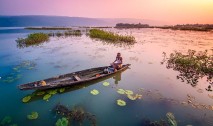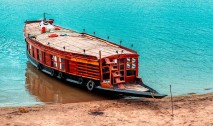Plant
Implementation of the Hower Master Plan (2012-2032)
In order to improve the quality of life of the people of Haor area in the north-eastern part of the country, with the aim of overall development including preservation of the environment, the Haor Master Plan was formulated for a period of 20 years from 2012 to 2032, the estimated cost of which was Tk 28,04,305 lakhs. In this master plan, 17 development sectors (water resources, agriculture, fisheries, pearl farming, livestock, biodiversity and wetland, 154 development project areas (transport, water supply and sanitation, housing and settlement, education, health, tourism, social services, industry, power and energy and mineral resources) have been identified. 40 government departments/organizations of various ministries of Bangladesh government in Haor area have taken up 175 projects for short, medium and long term implementation. Currently, 73 development projects are being implemented by various ministries, departments and organizations in Haor area and 102 projects have already been completed.
A total of 68 projects are currently underway under the Development Area/Sector wise Master Plan (2012-2032).
Water supply and sanitation, housing, fisheries, biodiversity and wetlands, tourism, industry, mineral resources and settlements are more important in taking up projects under the Haor Master Plan, so there are opportunities to take up more projects in the mentioned areas. As Haor region is impoverished and underprivileged, benefits of all projects need to reach all areas equally. In this case, there is a need to determine the implementation strategy of development activities by prioritizing the project areas of basic needs. Taking into consideration the above issues, the Master Plan Update Program has been undertaken in the light of Eighth Five Year Plan, SDG, Delta Plan 2100.
Agriculture
The benefits which are expected from agriculture Development Area is based on total cropped area, area and production of rice and non-rice production, cropping intensity, extension of irrigated area by both surface and groundwater. It has been estimated that the total cropped area will be increased from 1.93 to 2.36 million ha though the net cultivated area will decrease from 1.31 to 1.22 million ha. The cropping intensity will be increased to 187% from the present value of 147% through use of HYV, appropriate use of fertilizer, pesticides, and irrigation etc. The rice and non-rice area will be increased from 1.74 to 1.93 million ha and from 0.19 to 0.43 million ha respectively. The total production of rice and non-rice will be increased from 5.25 to 6.55 million ton and from 1.53 to 2.49 million ton respectively. The total irrigated area will be increased from 0.817 to 0.957 million ha.
Forest
The benefit which is expected from the forest Development Area is based on the increased fuelwood supply, restoration of environmental sustainability, reduced exposure of uncovered lands like “Ijmali” lands etc. These benefits can be brought through establishment of upazila forest nursery; afforestation in “Ijmali” lands; creation of freshwater wetland forest; roadside plantation; and community involvement in forest management. Implementation of the plan will result in increased plantation for both hill and agro forest and strip plantation. Additional 14,000 ha of hill and agro forest will be increased by 2030 involving local community. Similarly, additional 5,000 km of strip plantation will be increased on side of the road, embankment and homesteads by 2030. Restoration of the “Ijmali” land covering 4,180 ha and establishment of a 2 hectare upazila nursery has been considered in the plan to materialize the benefits in the forest Development Area
Conclusion
Haor is an eye-catching beauty of vast bodies of water all around. The appearance and beauty of Haor changes with the seasons. In the dry season, Howar has miles of cropland, dusty dirt roads, and silvery rivers. Haor water swells during monsoon. Two banks overflowed and flooded the crop fields. Haor then assumed the form of a raging sea. During the monsoons, the villages located in the sea-like haors then appear almost like islands.
Such diversity of life and nature of Haor can become the center of attraction for local and foreign tourists. Haor has been contributing for ages to meet the demand of rice and fish in Bangladesh. There are large natural fish stocks and large paddy production areas. One-fifth of the country's total rice production comes from this region. Swarnagarbha is a golden crop field and this haor of Ratœgarbha Jalmahal is a horizon of immense potential for developing fisheries and agricultural projects.
If all kinds of facilities are created in our country, there will be a huge demand for Haor-centric tourism. Tourists and visitors will be impressed by the natural beauty of Haor-Baor's hijal, cane, karach, Nalkhagra forest, various species of forest-aquatic animals and the natural beauty of the life and livelihood of the people living in Haorpara. Due to the abundance of water bodies in this country, a lot of snails and mussels are produced. Which is a priceless resource of nature. Haor also has a unique contribution to our cultural richness. Hasan Raja, Ukil Munshi, Baul Samrat Shah Abdul Karim have reached a unique height of musical repertoire of Howran area. Ancient arenas, temples and mosques are scattered with ancient and glorious monuments of Haor. Tourism in the Haor area can play a significant role in creating alternative employment opportunities for the water-bound Haor people during monsoons.
The department's journey is not long, yet in this limited time, the information and recommendations of the survey project implemented by the Bangladesh Water and Wetland Development Department are playing a helpful role in the adoption of development projects of various departments/organizations with the aim of protecting the country's aquatic ecosystem and biodiversity and improving the quality of life. In addition to this, initiatives are being taken to undertake survey projects as well as investment projects to ensure integrated sustainable management to protect the aquatic environment and biodiversity and improve the quality of life of people centered on wetlands.









